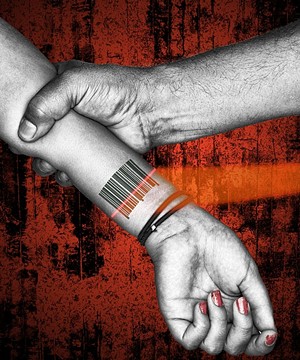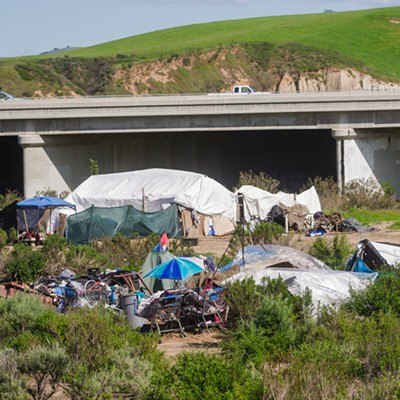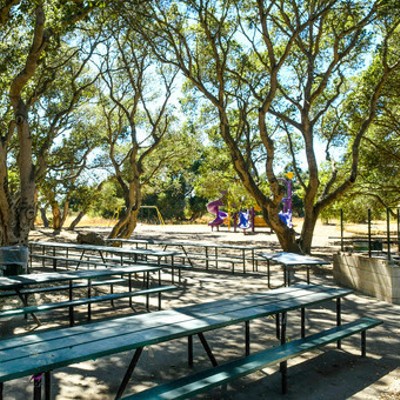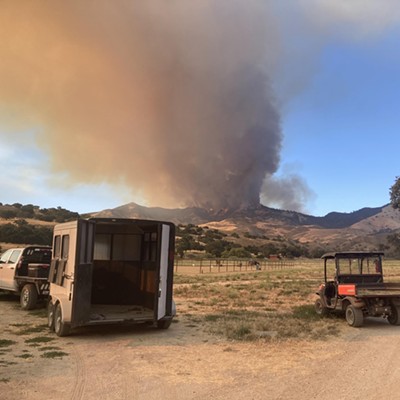May 18, 2016, marked a grim milestone in Santa Barbara County, as a Santa Maria jury found Humberto Carranza and Cameron Jones guilty of several counts of trafficking of a minor for sex. The case was one of the first human trafficking convictions in Santa Maria or North Santa Barbara County history.
In the county as a whole, the first human trafficking case prosecuted to conviction came just more than a year before, in February of 2015, when Brannon Pitcher was found guilty of trafficking a 16-year-old in Santa Barbara. Pitcher was caught in Santa Barbara after trafficking the youth in several counties along the coast, which is a common way traffickers avoid the attention of law enforcement.
But traffickers aren’t always on the move, and the Santa Maria case involving Carranza and Jones is a prime example. The two men, ages 24 and 27, found their victim in Santa Maria and convinced her to run away from home. The two took advantage of her sexually multiple times before advertising her for sex on a Craigslist ad, Santa Barbara County Deputy District Attorney Jennifer Karapetian told the Sun.
Karapetian prosecuted the case against the two men, and said that it went against the common stereotype of human trafficking, which many see as a problem that comes to an area rather than fomenting within it.
“It raises awareness that this is happening here to our local children in our community, and it shows that this can happen to anybody in Santa Maria,” Karapetian said. “There are obviously risk factors that cause children to end up in a lifestyle and they become victims, but it can really happen to a lot of children, and it is a problem that we all need to deal with, be aware of, and address.”
Misconceptions about human trafficking are prevalent in the general populace. It couldn’t have been more apparent than at the jury selection for the Carranza/Jones case.
Several potential jurors misunderstood the full scope of human trafficking and had to be educated, she said.
“It was interesting to learn what potential jurors’ initial perceptions were of human trafficking,” Karapetian said. “Some people assumed that it involved bringing people over from other countries in cargo ships. Others believed that it involved forced sexual slavery. While both of these may involve human trafficking, they are its rarest forms. The crime of human trafficking is like a broad umbrella that encompasses a few different kinds of conduct, and it commonly involves non-forced pimping or pandering of minors.”
The two recent cases in Santa Barbara County illustrate the existance of human trafficking in the area, but they certainly aren’t the first occurrences. The problem has been present for quite some time, but now county law enforcement, mental health, and social service providers are collaborating in an unprecedented way to address the issue.
And at the state level, lawmakers are taking notice as well. The California Assembly just approved Sen. Holly Mitchell’s (D-Los Angeles) bill, SB 1322, which would bar criminal charges against minors for prostitution. The bill sheds light on the conversation that many in social services, mental health, and law enforcement are having, which is that minors who are having sex for money should not be called prostitutes or charged as such. A minor cannot consent to sex under the law, and so charging them with prostitution ignores the fact that they have fallen victim to a modern form of physical slavery.
Identifying the problem
The realities of child sex trafficking in the North County became apparent to Lisa Conn, a licensed marriage and family therapist, when she began working at Juvenile Hall as a mental health worker.
While there, Conn noticed an alarming trend among the female inmates in juvenile detention, she told the Sun.
“I recognized that almost all of the females that were in there had very significant trauma that they had experienced in childhood, in particular sex trauma,” she said. “When I would go to apply my typical trauma-informed treatment that I had relied on for years and years, it didn’t have the same positive effect.”
After some digging, Conn was able to confirm that a handful of the girls were definitely trafficked before they were incarcerated. Many others showed the same signs, but were obstinate and kept quiet about it.
The girls showed many of the typical signs of abuse and trauma, including depression, anxiety, and Post Traumatic Stress Disorder (PTSD). But most of the girls who had been trafficked exhibited oppositional behavior, aggression, and excessive mistrust of authority figures, Conn said. These symptoms have made it difficult for law enforcement to identify them as trauma victims and get them to cooperate in an investigation, Conn explained.
“They are difficult to connect to because they are acting out, they don’t trust you, and they’re very fearful,” Conn said. “They look like a super oppositional delinquent, and our society doesn’t have a lot of patience or empathy for that.”
Today, Conn is the supervisor of the RISE Project in Santa Maria. The organization, which is part of the Santa Barbara County Department of Behavioral Wellness, stands for Resiliency and Intervention for Sexual Exploitation (RISE). The organization’s entire mission is to support and empower victims of sexual exploitation or trafficking.
Conn has become intimately aware of the factors that lead a young girl down the path toward being trafficked. The biggest risk factors are childhood abuse or neglect, a history of running away, time in foster care, time in juvenile detention, and homelessness.
Many of the girls helped by the RISE Project became homeless after running away from an abusive household, Conn said, which is the time they usually met the predators who ended up exploiting them. These men, often in their 20s or 30s, meet the girls’ most immediate needs first—like food, housing, or clothing—then they meet their emotional needs, before taking advantage of them sexually. This creates a multifaceted dependence that is hard to break.
“What goes on most of the time is that there is a grooming process, like what we see with pedophiles,” Conn said. “Some of our girls are groomed for months over the internet, like on Facebook or Snapchat, and he’s there saying, ‘You’re so beautiful, you’re so smart, and your parents just don’t understand you.’ And sometimes sex isn’t even involved right away.”
As local law enforcement became aware of homegrown human trafficking, the issue of transient traffickers and victims coming through the county came up as well. Santa Barbara and Santa Maria are both ideal targets for traffickers because both are located on Highway 101, are quite populous, and are popular tourist destinations, explained the DA’s Office’s Victim-Witness Assistance Program Director Megan Rheinschild
Rheinschild is the facilitator for the Santa Barbara County District Attorney Office’s Human Trafficking Task Force. The task force was formed in 2014 after repeated warnings about the issue from law enforcement elsewhere in the state, Rheinschild explained.
“I had people telling me in other parts of the state, mainly LA, saying, ‘Hey, you guys are on this corridor between the northern part of the state and the southern part of the state, and you got a problem,’” she said. “We weren’t seeing it, because it’s not like victims of sexual exploitation or trafficking come knocking at our door at the DA’s Office saying, ‘Can you help me?’
“And lo and behold, as we started doing more research, formed our task force, and started doing outreach and education, I was pretty blown away,” she continued. “It takes a lot after you’ve been in this business a while to be blown away, but it quickly became apparent that yes, my colleague in LA was right.”
Addressing the issue
The DA’s Office’s Human Trafficking Task Force represents the collaboration of dozens of government agencies, nonprofits, and private organizations. It involves local and federal law enforcement, behavioral wellness, faith organizations, child welfare services, and even health care providers.

The DA’s Office has led the charge because it can work with all the other local, state, and federal law enforcement agencies, Rheinschild explained. The city police departments, Santa Barbara County Sheriff’s Office, California Highway Patrol, the FBI, Homeland Security, and U.S. Attorney’s Office all have a place at the table, she said.
Collaboration between law enforcement, nonprofit organizations, and other government agencies has led to not just an increase of awareness of human trafficking, but increased funding to address it as well. According to Santa Barbara County Sheriff’s Office Lt. Brian Olmstead, his department is working toward obtaining a grant that will fund a dedicated human trafficking investigator.
“There’s more and more funding that is starting to come in, so they’re starting to release these grants to identify a dedicated person for human trafficking,” Olmstead said. “Right now it sort of falls under a couple different areas, like our Crimes Against Persons Unit, our narcotics investigators, our vice investigators. So, it’s getting bigger and bigger, but right now we don’t have a dedicated person where that’s all they do, to attack human trafficking.”
However, a few Sheriff’s deputies just attended classes in Los Angeles, he said, which educated them on how to track and arrest traffickers.
Education is one thing, but large-scale operations are another all together.
The Sheriff Office’s Special Investigations Bureau and Santa Barbara police officers recently collaborated on a reverse sting operation in Goleta, on July 7 and 8. Investigators in the Special Investigations Bureau placed an online advertisement on backpage.com, an online ad site popular with prostitutes and traffickers alike, which received more than 60 responses, Olmstead said.
Ultimately, 20 men between the ages of 20 and 66 actually answered the ad, arriving at the motel in Goleta where Sheriff’s deputies were waiting to arrest the solicitors.
“It’s a few things. If we can lower the demand then there won’t be the need to provide so many victims to traffic,” Olmstead said, “and that’s only a small little dent.
“But that’s a really hard thing to do, and it takes so many resources to do so,” he continued. “We had one sting, where it was really a night and a half to get things started, and we had over 60 people respond to our ad, and when you look on the websites where we posted, there are multiple people in the area offering services.”
The logistics of such a sting, from a department standpoint, are taxing, Olmstead said. There were more than a dozen deputies involved, he explained, all with a crucial job. There were some points where Sheriff’s deputies were barely finished with processing one suspect before the next was knocking on the motel room door, he said.
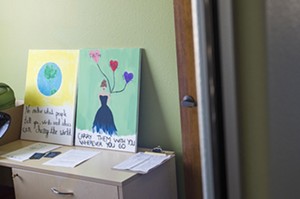
Olmstead also explained that he and his department hope to conduct stings in the future that target the traffickers specifically. Newer laws grant harsher sentences to traffickers, he explained, and may deter more men from trafficking girls.
But once arrests are made by law enforcement, specifically of traffickers and their victims, a whole new host of problems arise. The victims are often intensely loyal to their abusers, RISE’s Conn explained. In what Conn described as a “cult-like” level of indoctrination, victims are often conditioned, or intimidated, from testifying against their traffickers.
The DA’s office and the task force also recognize that in order to convict more traffickers, law enforcement, mental health, and social service workers have to do more to reach out to the young girls victimized by the predators. Deputy District Attorney Von Nguyen, who prosecuted the Brannon Pitcher case last year, explained how important it is for victims to come forward and be cooperative. But the DA also has to balance its need to prosecute with the safety of these victimized girls.
“First and foremost, for us, it’s about getting them to a safe place and a healthy place if we can,” Nguyen said. “Sometimes forcing them to testify may be a difficult thing, and we have to weigh that. We can’t just look at it blindly and not think about the collateral consequence or effects of what might happen by putting a victim through a very grueling trial. You can imagine the level of cross-examination that they would have to endure. It’s hard to watch that, it can be devastating.
“We want to make sure that they’re OK,” Nguyen continued. “That’s the most important thing from our standpoint from our office, while at the same time doing everything we can to make sure the traffickers are held accountable for their actions. It’s trying for everybody involved, from the victims to our advocates all the way to the prosecutors. It’s an incredibly grueling process, but I think getting one trafficker off the streets is certainly well worth it.”
Hope and healing
The work that Conn and her staff at the RISE Project in Santa Maria do aims to help young victims and address the overall issue of human trafficking on several fronts.
One Girl
One hundred owners
One lost soul
One hundred users
One heart
One hundred spared parts
Countless band-aids
One hundred marks
One love
One hundred times replaced
One keeper
One hundred times erased
Touched spirits
Wounded souls
Body taken
Feelings hidden
A piece of property,
that’s all she sees
Love is what she was told
Born into a world that is sold
Precious blind babies, sold in a world
of use and abuse for money
One hundred girls
One thousand owners
One thousand lost souls
One too many users
The organization offers trauma-specific treatment to girls and young women who have been sexually exploited commercially, are “at risk” of exploitation, or have a history in juvenile detention, foster care, group homes, or homelessness. The treatment includes medical support, advocate support, peers and mentor support, incentive programs, crisis intervention, pro-social opportunities, body positivity exercises, creative outlet classes, and mental and physical wellness classes.
It is deep, multilayered, and highly adaptive work for staff and subjects, Conn said. But first and foremost, she explained, the RISE Project caseworkers and office serve as a vital source of positive adult support in the lives of youth who may not have any.
“We just want them to know that we are the one adult in their life that isn’t going to judge them or ask, ‘What is wrong with you, why are you doing this?’” Conn said. “We know why they are doing this, why would we ask them, ‘Why are you having trauma symptoms?’ You don’t ask somebody a question like that who is exhibiting a normal reaction to intense and immense childhood trauma—compounded traumas.”
Being adaptive to the victims’ needs could mean a lot of different things for RISE staff, Conn explained. Many of the girls are transient between multiple homes, she said, so often her staff will meet them out and about, at a park or a coffee shop. Sometimes a counseling session may last only five minutes before the girl becomes uncomfortable with moving forward. That’s fine too, Conn said.
The RISE Project takes its wards through a tiered system of recovery, designed to help girls discover their “true self” and get free from the constant survival mode they have been in, often for years. The first objective is stabilization, which acclimates wards to care providers, builds rapport, and teaches distress tolerance. The next step involves integrating coping strategies through goal building, wellness classes, and family or community outreach. The girls then reach the maintenance tier, which includes a vast amount of education and group work. The final stage moves them into a leadership role, where they are mentoring other youth in previous stages of the program along with performing many other progressive programs and therapy.
“It’s a biopsychosocial empowerment approach,” Conn said. “We don’t focus on what’s wrong with you, we only focus on what’s right, building on the strengths that they have, and building resiliency for a girl to live their life. We want them to have a quality of life that is meaningful for them.”
Building meaning in a life of survival is a saving grace for the girls, Conn explained, but it’s something that they have to find for themselves. A lot of what the RISE Project does is provide a safe place for the girls to try something new, something creative, or just something different. The girls get yoga classes, dance classes, creative writing, or music lessons as part of this therapy, she said.
Meeting the girls at their level can be challenging, Conn said, but the RISE Project does everything it can to build inroads. Conn called on the help of Carissa Phelps, attorney, author, and founder of Runaway Girl Inc. to consult with the RISE Project. Phelps is a survivor of youth trafficking who went on to graduate UCLA School of Law, write the book Runaway Girl, and become a powerful advocate for trafficked youth.
Phelps consults with many different organizations and agencies, she explained, and remarked that the RISE Project is a model organization when it comes to aiding trafficking victims in a holistic way. The most powerful resource that organizations like the RISE Project can provide are relationships, Phelps said, specifically positive relationships based on respect and unconditional support with therapists, counselors, and peers. The rapport can be difficult to build, but it’s necessary for recovery, she said.
“It takes time, it takes consistency,” Phelps said. “It takes showing up when no else is showing up, not blaming them for their outbursts, it takes understanding all of that before you go in.”
Moving beyond the abuse is an important factor as well, Phelps said. That’s why creative outlets play an important role in recovery, Conn explained.
In the poem “One Too Many,” a RISE Project ward explored her experience and trafficking in general. The poem—which the Sun has published fully on page 11—is just one small piece of one girl’s journey in recovery, Conn said.
“She has far surpassed every single thing I thought was possible for her,” Conn said. “She has moved through some very difficult times, and struggles still on a regular basis, but has done some amazing things.”
The other side of the RISE Project’s mission is to broadcast a message of positivity to young women and to the greater community, that there is hope for those who have been through this profound trauma and abuse. Everyone can help remove the stigma put on young people who have been trafficked, Conn explained, but it’s going to take open ears and open hearts to actually help those most in need.
“This is an opportunity for them to see this, and say, ‘OK, the world isn’t against me, somebody does understand,’” Conn said. “There are survivors in our community, right now, in Santa Barbara County. They are here. You might not see them, but trust me, they are there.”
The following information is from the Santa Barbara County District Attorney’s Needs Assessment of Domestic Child Sex Trafficking in Santa Barbara County of 2015.
Local problem
Of the 45 confirmed child survivors of sex trafficking identified in the 2015 report, 43 were residents of Santa Barbara County. Two were not residents of the county.
Identifying victims
Mental health staff at the county’s juvenile halls, law enforcement in the field, and social service providers identified the 45 confirmed victims of child sex trafficking in Santa Barbara County for the 2015 report. Mental health staff in the county’s juvenile halls identified 44 percent of the victims. Law enforcement identified 42 percent of the victims. Social service providers identified 13 percent of the victims.
Common characteristics
In addition to the gender and age of child survivors of domestic sex trafficking, the most common factors that put youth at risk are history of abuse or neglect, involvement with the foster care system, history of running away, homelessness, and involvement in the juvenile justice system.
Age
Of the 45 identified victims, additional information was available from 15 of them, including age. One was 11 years old, two were 12 years old, one was 13 years old, three were 14 years old, two were 15 years old, three were 16 years old, two were 17 years old, and one had just turned 18 at the time they were identified.
Gender
Of the 45 confirmed child survivors of domestic sex trafficking, 44 were female and one was male.
Race
Of 15 confirmed survivors where additional information was available, six were African-American, five were latina, three were white, and one was of mixed ethnicity.
Contact Arts Editor Joe Payne at [email protected].


